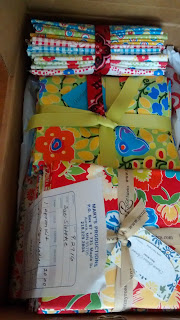There have been many bloggers talking about color value. I took a class several years ago with June Coburn on color theory. She led us through several exercises to do color value analysis. I have retained some of it, and try to remember what she taught us that day.
I think I have a pretty good color sense and memory. It's like my eyes remember a color of fabric or yarn I have and I can come pretty close to picking out things that coordinate, even if I don't have the original fabric with me. Sometimes I fail but mostly I do OK.
I was cleaning up a bit in the church guild supply cabinet last week and I set things into general color families on the table. Things are easier to work with if they're organized. The reddish stripe landed next to the star fabric. You can't see it too well but there's a green stripe in that fabric.
The fabric to the left of the stripe is green leaves. It's a pretty good blend. We have this pattern that needs six colors of strips, so I pulled in the tan and the white, and that floral with the gray background because there's green and tan and white in it.
I was not exactly thrilled with that final, because the gray kind of made groaning noise with this combo. I took the pile home and found the far left fabric, which is really much more gray than blue as it shows in the photo, but that's my basement light fighting my camera.
So now I have seven fabrics.
I made the photo black and white. There's only one dark fabric, the green leaves fabric in the center. Four fabrics read as medium and two are light.
General thinking is that most people tend to buy mediums. Some of us have to struggle to pick up lights or darks. If you see the fabrics in color, you see differences. Red is not green, blue and green can be differentiated by most human eyes from yellow...
But change them all to B&W, and some things kind of run together. In the picture above, the stripe, the stars and the florals have flashes of white attached. Depending upon the amount of white, the values can read as similar or you might see contrast but the difference is not as noticeable. Light is light but the only fabric that reads as dark is the center fabric.
That still makes a lovely quilt, but might be classified by some as low volume or low contrast. And that's OK, that might be just the look you want!
The quilt that comes out of this group will still have contrast. I'm still thinking that I might need to pull those two fabrics with gray out and come back with something very dark, like forest or black, that either is solid or reads as a solid.
It remains to be seen how this one will turn out. This is not my general color wheelhouse but that reddish fabric appeals to me for some reason. I think I'm going to like it if I make the right choice on the sixth fabric. Stay tuned!
Sew on...














